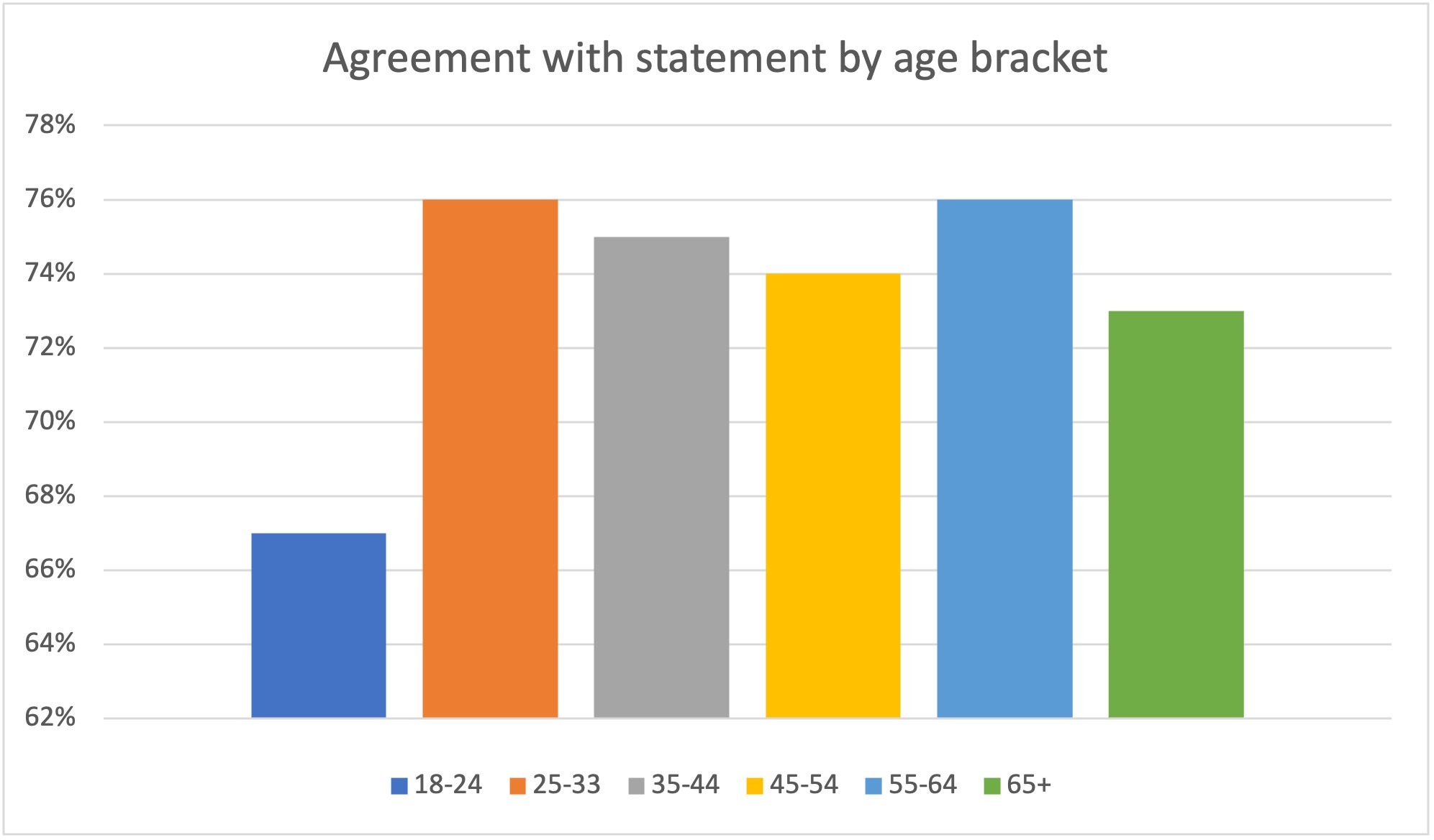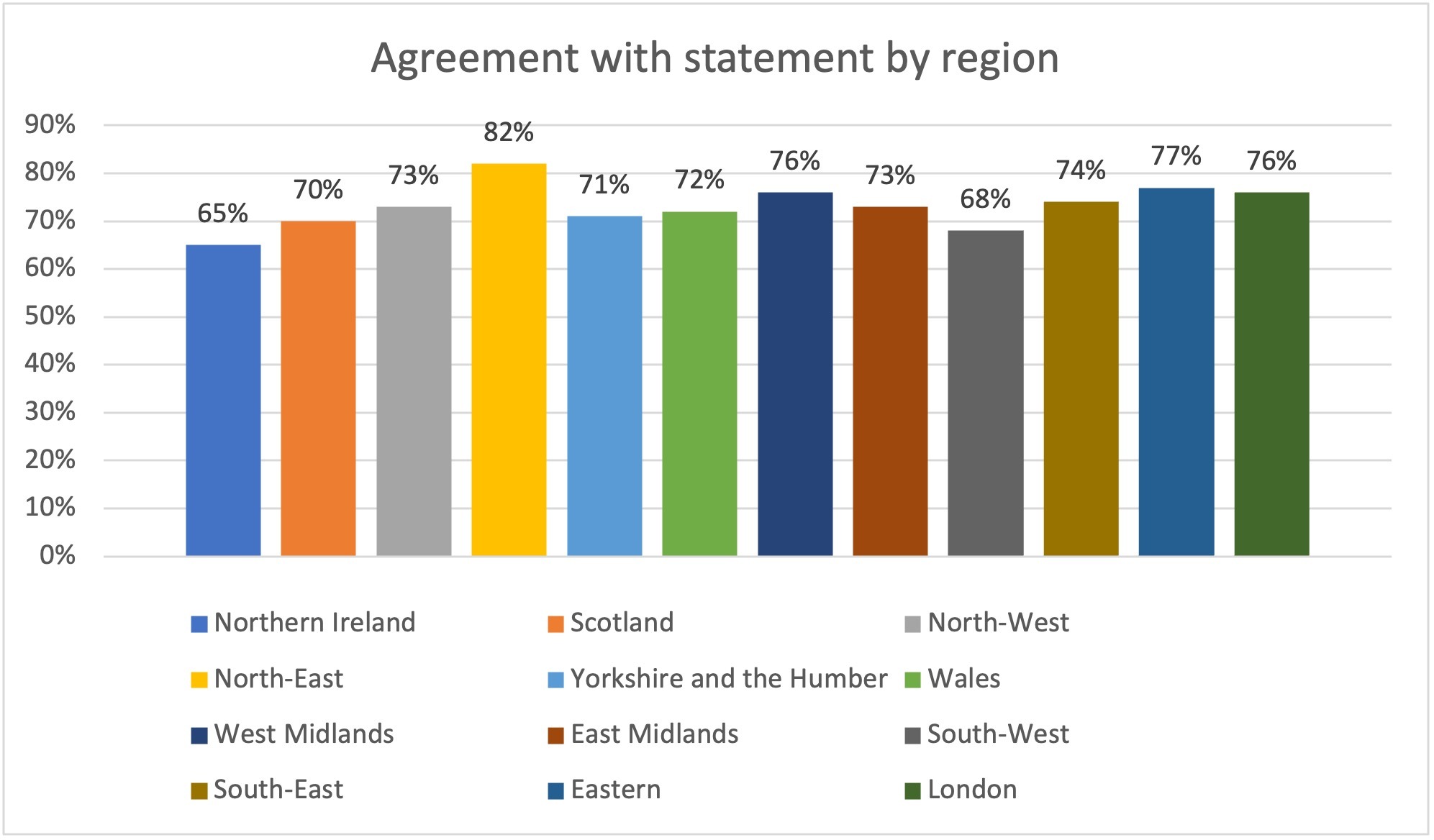
- Nearly three-quarters of the public agree: One-to-one tutoring greatly boosts a child’s confidence.
- Strongest support from North East England: 82% say tutoring significantly enhances a child’s self-assurance.
- Younger adults less convinced: Confidence-boosting effects of tutoring are viewed less positively by 18-24-year-olds.
- Not all regions are on board: Northern Ireland shows the lowest level of agreement, with just 65% backing the claim.
No Nonsense National Survey Programme 2024-25 assessed levels of agreement to the following statement:
‘Usually, one-to-one tutoring greatly improves a school child’s confidence.’
Methodology:
- 2000+ respondents
- National representation
- Year: 2024
NATIONAL FINDINGS
73% of respondents agreed that one-to-one tutoring usually greatly improves a school child’s confidence.
This could be because there is reduced peer pressure in a one-to-one setting.
Without the presence of classmates, students might feel less pressure to compete or compare themselves with others.[1]
This reduction in peer pressure can create a more relaxed learning environment where students can focus on their personal growth and confidence without the distraction of others.[2]
In a one-to-one setting, students may also feel more comfortable asking questions and expressing their difficulties without the fear of judgment from their peers.[3]
This supportive environment can encourage students to engage more actively in the learning process, simultaneously boosting their confidence.[4]
Finally, one-to-one tutoring can help a student overcome specific academic challenges they face in the classroom.
Successfully tackling these obstacles can significantly enhance a student’s confidence in their ability to handle subjects they find difficult.[5]
AGE VARIATIONS
Between the different brackets within 25-64-year olds (25-34, 35-44, 45-54 and 55-64), there was a consistently high level of agreement, with the lowest percentage at 74% (45-54).
This can be explained by these age groups having school age children or grandchildren and therefore the likelihood that their children’s confidence has increased through a positive experience of one-to-one tutoring is greater.
Similarly, the likelihood that respondents in these age groups have family members or friends who have had a positive experience with one-to-one tutoring for their children is greater.

The lowest level of agreement from respondents was in the 18-24-year-old age bracket at 67%.
This is not surprising either as this age group are less likely to have children of their own and will likely be in tertiary education or have only just started full-time work.
Aside from having not necessarily benefited from one-to-one tutoring themselves, respondents within this age bracket are actually more likely to be working either part-time or full-time as a tutor themselves, and subsequently might be less likely to visibly see the effects of their work in building confidence through one-to-one tutoring.
Additionally, younger people are more likely to challenge conventional ideology, especially with regard to education which includes one-to-one tutoring.
They often favour peer learning, group projects and other more modern educational approaches over traditional methods such as one-to-one tutoring, and also might perceive tutoring as being a remedial tool for students who are struggling, rather than as a tool for enhancing success.[6]
REGIONAL VARIATIONS
The highest level of agreement from respondents was in the North East at 82%.
This is a somewhat surprising statistic, given how research from 2023 showed that the North East had one of the lowest percentages young people (11-16) having ever received private tutoring (16%), especially compared to London (46%).[7]
This would indicate that a comparative lack of access regarding private, one-to-one tutoring in the Northeast.
However, in regions where resources are limited, education can be perceived as a means of social mobility.[8]
Respondents in this region might view one-to-one tutoring as paramount for helping children overcoming socioeconomic obstacles and achieving success and therefore have a greater appreciation of its benefits.[9]

Conversely, in Northern Ireland, the level of agreement from respondents dropped to as low as 65%.
This could be due to a perceived stigma with receiving one-to-one tutoring, where students or parents feel that needing a tutor indicates a failure to succeed within the regular school environment and subsequently the knock-on effect that this could have on a student’s self-esteem and confidence.[10]
However, a more likely explanation for the perception of private tutoring’s impact on student confidence might be a lack of quality or consistency of one-to-one tutoring available in Northern Ireland.[11]
Poorer socioeconomic conditions in Northern Ireland potentially limit the access to high-quality one-to-one tutors.[12]
References:
[1] Elliott, J. G., & Gibbs, S. – Does dyslexia exist? (Journal of Philosophy of Education)
[2] Ibid.
[4] Ibid.
[7] Carl Cullinane and Rebecca Montacute – Tutoring – The New Landscape, Recent trends in private and school-based tutoring (The Sutton Trust)
[9] Ibid.
[10] Why Most Tutoring Doesn’t Work — and What Does (Inspiration Education)
[11] Connor Lynch – Nearly 80% of teaching graduates leaving Northern Ireland (Belfast Live)
[12] Ibid.
